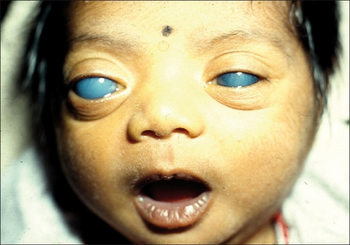Primary juvenile glaucoma
| Primary juvenile glaucoma | |
|---|---|
 | |
| A child with right eye buphthalmos, developed due to congenital glaucoma. | |
| Specialty | Ophthalmology |
| Treatment | Goniotomy, trabeculotomy[1] |
Primary juvenile glaucoma is glaucoma that develops due to ocular hypertension and is evident either at birth or within the first few years of life.[2] It is caused due to abnormalities in the anterior chamber angle development that obstruct aqueous outflow in the absence of systemic anomalies or other ocular malformation.[3]
Signs and symptoms

The typical infant who has congenital glaucoma usually is initially referred to an ophthalmologist because of apparent corneal edema. The commonly described triad of epiphora (excessive tearing), blepharospasm and photophobia may be missed until the corneal edema becomes apparent.[3]
Systemic associations
Two of the more commonly encountered disorders that may be associated with congenital glaucoma are Aniridia and Sturge-Weber syndrome.[citation needed]
Genetics
JOAG is an autosomal dominant condition. The primary cause is the myocilin protein dysfunction. Myocilin gene mutations are identified in approximately 10% of patients affected by juvenile glaucoma.
Diagnosis
The diagnosis is clinical. The intraocular pressure (IOP) can be measured in the office in a conscious swaddled infant using a Tonopen or hand-held Goldmann tonometer. Usually, the IOP in normal infants is in the range of 11-14 mmHg.[3] Buphthalmos and Haab's striae can often be seen in case of congenital glaucoma.[citation needed]
Differential diagnosis
Corneal cloudiness may have myriad of causes. Corneal opacity that results from hereditary dystrophies is usually symmetric. Corneal enlargement may result from megalocornea, a condition in which the diameter of the cornea is larger than usual and the eye is otherwise normal.[citation needed]
Treatment
The preferred treatment of congenital glaucoma is surgical, not medical. The initial procedures of choice are goniotomy or trabeculotomy if the cornea is clear, and trabeculectomy ab externo if the cornea is hazy. The success rates are similar for both procedures in patients with clear corneas. Trabeculectomy and shunt procedures should be reserved for those cases in which goniotomy or trabeculotomy has failed. Cyclophotocoagulation is necessary in some intractable cases but should be avoided whenever possible because of its potential adverse effects on the lens and the retina.[5]
Epidemiology
In the United States, the incidence of primary congenital glaucoma is about one in 10,000 live births. Worldwide, the incidence ranges from a low of 1:22,000 in Northern Ireland to a high of 1:2,500 in Saudi Arabia and 1:1,250 in Romania. In about two-thirds of cases, it is bilateral. The distribution between males and females varies with geography. In North America and Europe, it is more common in boys, whereas in Japan it is more common in girls.[6]
- Congenital glaucoma
- Incidence: one in every 10000-15000 live births.
- Bilateral in up to 80% of cases.
- Most cases are sporadic (90%). However, in the remaining 10% there appears to be a strong familial component.
See also
References
- ↑ "The glaucomas". Parsons' diseases of the eye (22nd ed.). New Delhi, India: Elsevier. 15 July 2015. ISBN 978-81-312-3818-9.
- ↑ Wiggs, JL; Damji, KF; Haines, JL; Pericak-Vance, MA; Allingham, RR (Jan 1996). "The distinction between juvenile and adult-onset primary open-angle glaucoma". American Journal of Human Genetics. 58 (1): 243–4. PMC 1914955. PMID 8554064.
- ↑ 3.0 3.1 3.2 Yanoff, Myron; Duker, Jay S. (2009). Ophthalmology (3rd ed.). Mosby Elsevier. ISBN 9780323043328.
- ↑ Abu-Amero, Khaled K.; Edward, Deepak P. (1993). "Primary Congenital Glaucoma". GeneReviews®. University of Washington, Seattle. Archived from the original on 31 July 2020. Retrieved 18 July 2022.
- ↑ Basic and clinical science course (2011–2012). Glaucoma. American Academy of Ophthalmology. ISBN 978-1615251179.
- ↑ Diagnosis and Treatment of Primary Congenital Glaucoma Archived 2014-10-19 at the Wayback Machine
Further reading
- Lively GD, Alward, WL, Fingert JH. Juvenile open-angle glaucoma: 22-year-old Caucasian female referred in 1990 for evaluation of elevated intraocular pressure (IOP) Archived 2021-04-11 at the Wayback Machine. EyeRounds.org. September 17, 2008.
External links
- 231300
- 137750; MYOC
- 137750; CYP1B1
- Juvenile Glaucoma at eMedicine on eMedicine
- Glaucoma for Children on AAPOS.
- Congenital Primary Glaucoma on patient.info
- GeneReview/NCBI/NIH/UW entry on Primary Congenital Glaucoma Archived 2020-07-31 at the Wayback Machine
- Glaucoma entry on PGCFA Archived 2016-11-12 at the Wayback Machine